ACC511 Financial Management: Capital Investment Decisions Analysis
VerifiedAdded on 2023/06/15
|20
|3256
|300
Project
AI Summary
This project provides a comprehensive analysis of capital investment decisions in two different cases. The first case, Dukeview Corporation Limited (DCL), evaluates a new contract opportunity using techniques like net present value (NPV), payback period, internal rate of return (IRR), accounting rate of return (ARR), and profitability index (PI). The analysis reveals mixed results, with some techniques favoring acceptance and others suggesting rejection. The second case, Curtis Industries Limited (CIL), assesses the financial feasibility of investing in a new contract, including NPV calculation and sensitivity analysis to changes in unit sales, selling price, and cost of capital. The project also includes a scenario analysis comparing it with sensitivity analysis and pricing of risk. The solution provides detailed calculations and explanations for each technique, offering valuable insights into the decision-making process for capital investments.
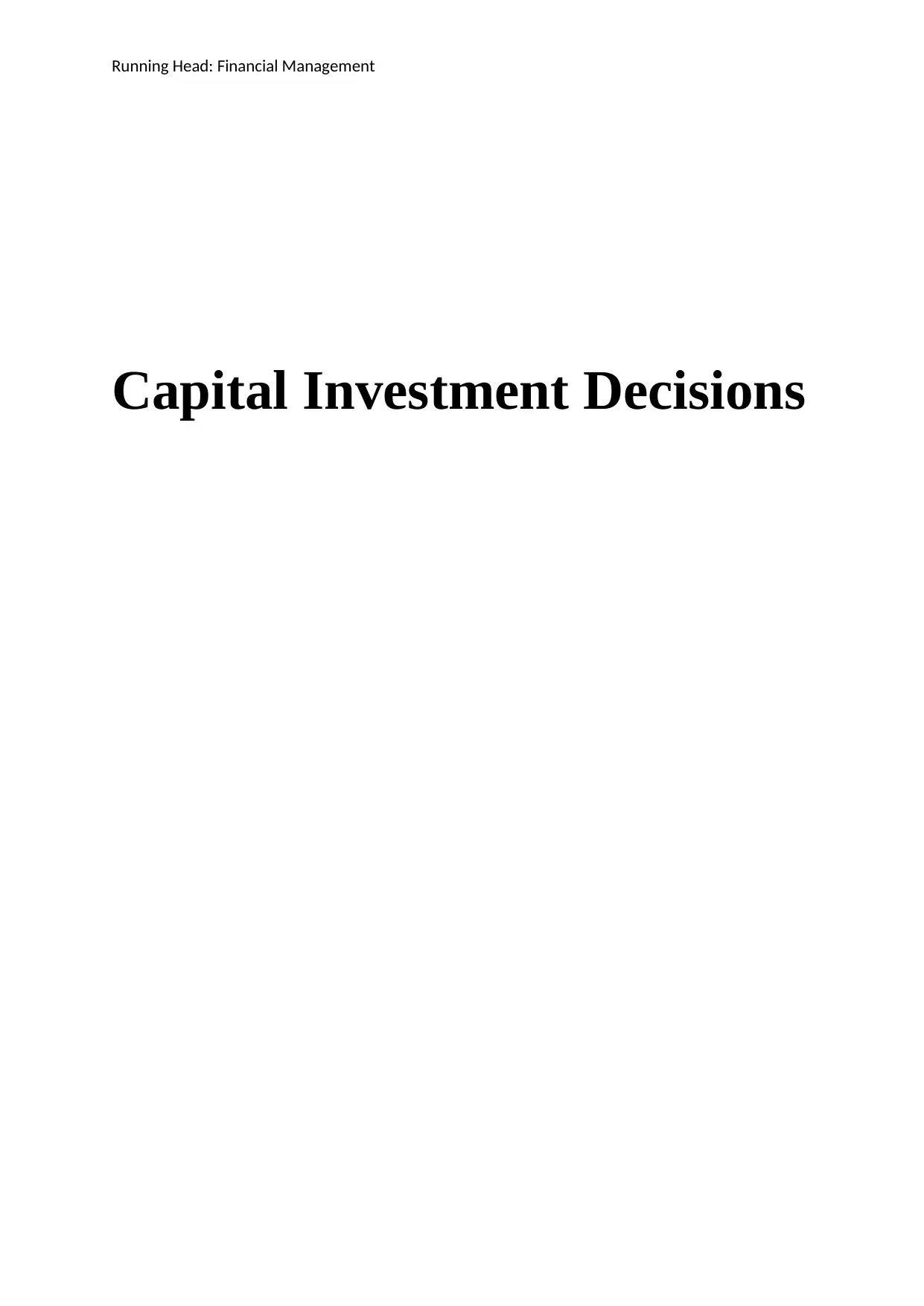
Running Head: Financial Management
Capital Investment Decisions
Capital Investment Decisions
Paraphrase This Document
Need a fresh take? Get an instant paraphrase of this document with our AI Paraphraser
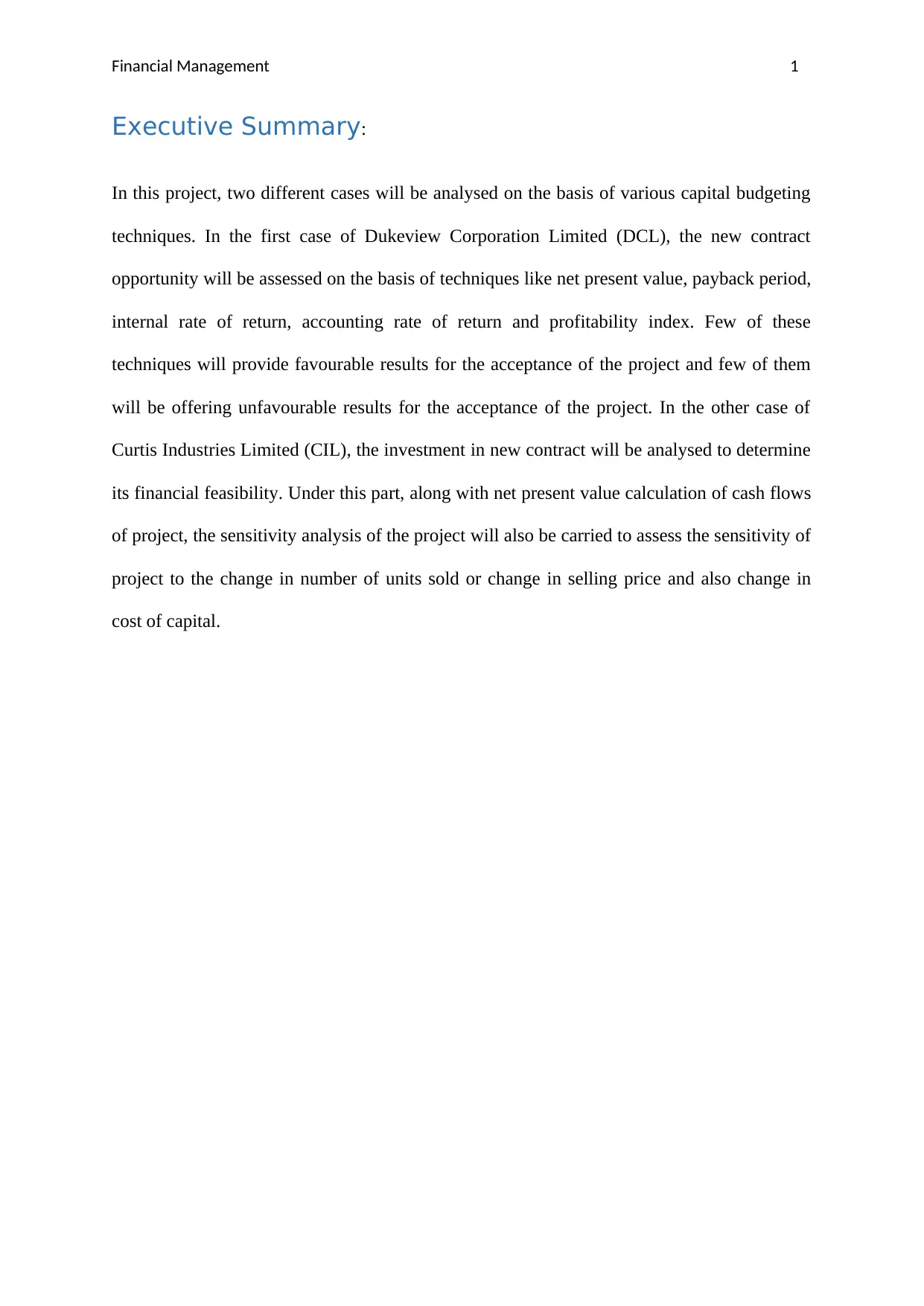
Financial Management 1
Executive Summary:
In this project, two different cases will be analysed on the basis of various capital budgeting
techniques. In the first case of Dukeview Corporation Limited (DCL), the new contract
opportunity will be assessed on the basis of techniques like net present value, payback period,
internal rate of return, accounting rate of return and profitability index. Few of these
techniques will provide favourable results for the acceptance of the project and few of them
will be offering unfavourable results for the acceptance of the project. In the other case of
Curtis Industries Limited (CIL), the investment in new contract will be analysed to determine
its financial feasibility. Under this part, along with net present value calculation of cash flows
of project, the sensitivity analysis of the project will also be carried to assess the sensitivity of
project to the change in number of units sold or change in selling price and also change in
cost of capital.
Executive Summary:
In this project, two different cases will be analysed on the basis of various capital budgeting
techniques. In the first case of Dukeview Corporation Limited (DCL), the new contract
opportunity will be assessed on the basis of techniques like net present value, payback period,
internal rate of return, accounting rate of return and profitability index. Few of these
techniques will provide favourable results for the acceptance of the project and few of them
will be offering unfavourable results for the acceptance of the project. In the other case of
Curtis Industries Limited (CIL), the investment in new contract will be analysed to determine
its financial feasibility. Under this part, along with net present value calculation of cash flows
of project, the sensitivity analysis of the project will also be carried to assess the sensitivity of
project to the change in number of units sold or change in selling price and also change in
cost of capital.
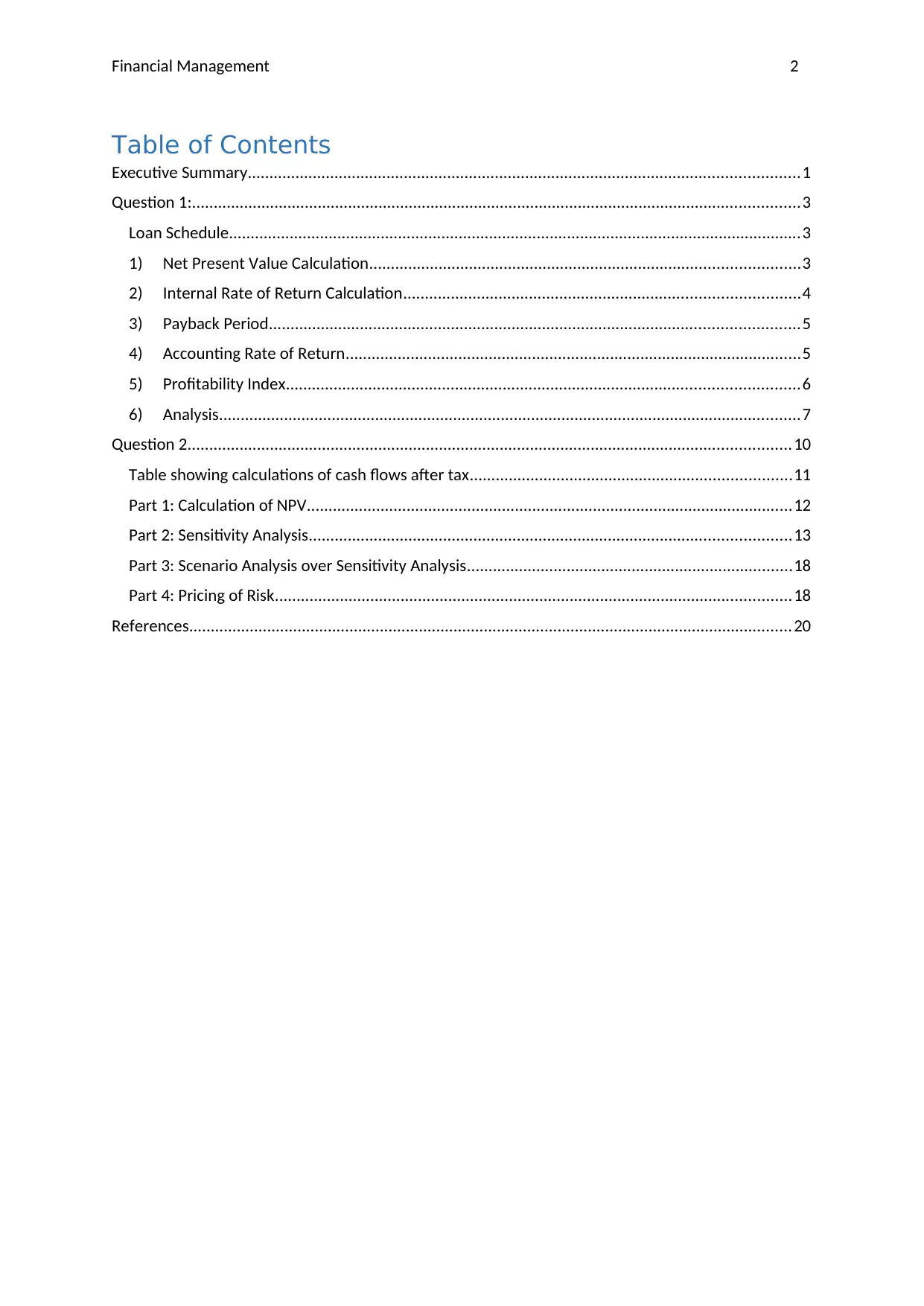
Financial Management 2
Table of Contents
Executive Summary...............................................................................................................................1
Question 1:............................................................................................................................................3
Loan Schedule....................................................................................................................................3
1) Net Present Value Calculation...................................................................................................3
2) Internal Rate of Return Calculation...........................................................................................4
3) Payback Period..........................................................................................................................5
4) Accounting Rate of Return.........................................................................................................5
5) Profitability Index......................................................................................................................6
6) Analysis......................................................................................................................................7
Question 2...........................................................................................................................................10
Table showing calculations of cash flows after tax..........................................................................11
Part 1: Calculation of NPV................................................................................................................12
Part 2: Sensitivity Analysis...............................................................................................................13
Part 3: Scenario Analysis over Sensitivity Analysis...........................................................................18
Part 4: Pricing of Risk.......................................................................................................................18
References...........................................................................................................................................20
Table of Contents
Executive Summary...............................................................................................................................1
Question 1:............................................................................................................................................3
Loan Schedule....................................................................................................................................3
1) Net Present Value Calculation...................................................................................................3
2) Internal Rate of Return Calculation...........................................................................................4
3) Payback Period..........................................................................................................................5
4) Accounting Rate of Return.........................................................................................................5
5) Profitability Index......................................................................................................................6
6) Analysis......................................................................................................................................7
Question 2...........................................................................................................................................10
Table showing calculations of cash flows after tax..........................................................................11
Part 1: Calculation of NPV................................................................................................................12
Part 2: Sensitivity Analysis...............................................................................................................13
Part 3: Scenario Analysis over Sensitivity Analysis...........................................................................18
Part 4: Pricing of Risk.......................................................................................................................18
References...........................................................................................................................................20
⊘ This is a preview!⊘
Do you want full access?
Subscribe today to unlock all pages.

Trusted by 1+ million students worldwide
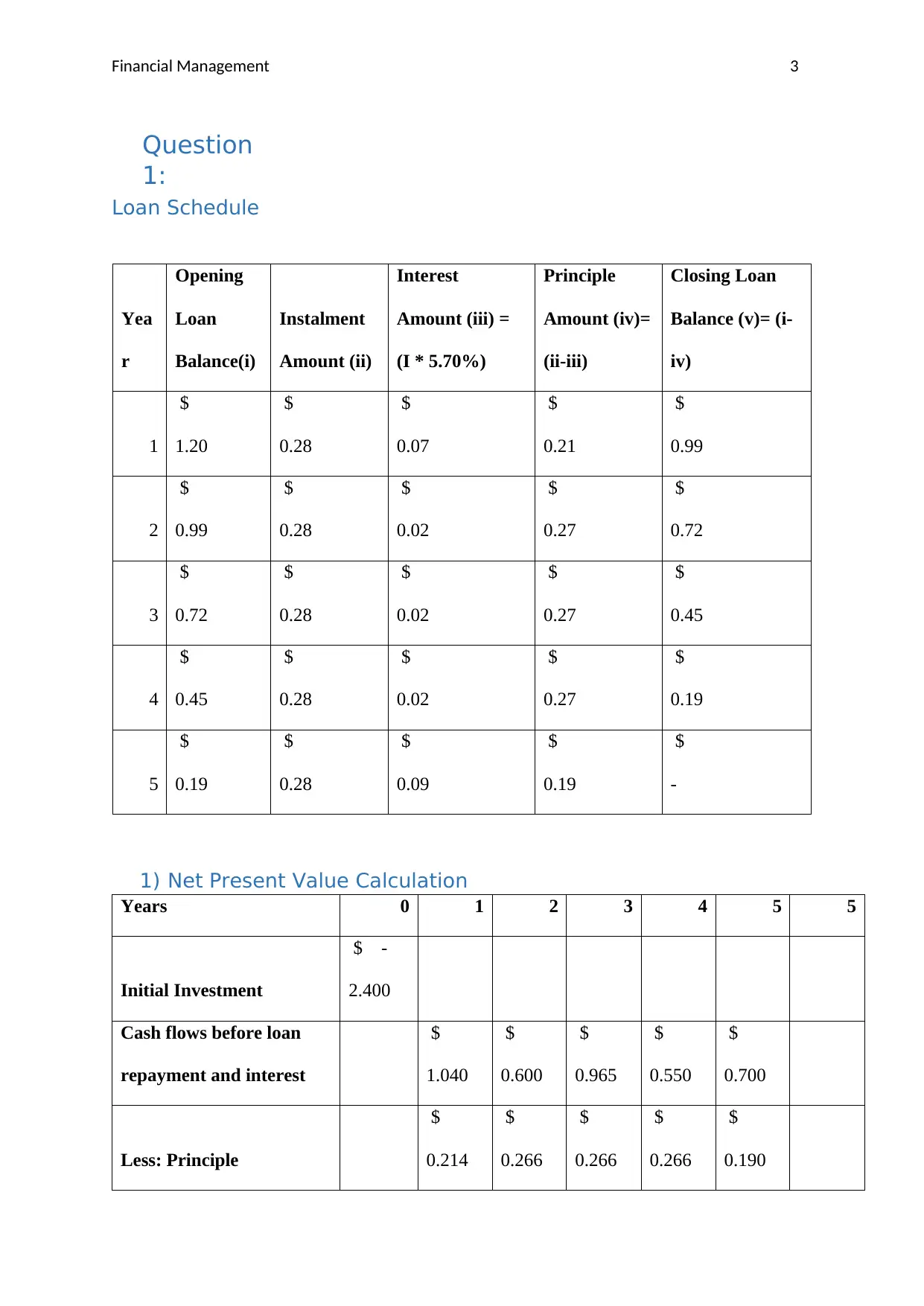
Financial Management 3
Question
1:
Loan Schedule
Yea
r
Opening
Loan
Balance(i)
Instalment
Amount (ii)
Interest
Amount (iii) =
(I * 5.70%)
Principle
Amount (iv)=
(ii-iii)
Closing Loan
Balance (v)= (i-
iv)
1
$
1.20
$
0.28
$
0.07
$
0.21
$
0.99
2
$
0.99
$
0.28
$
0.02
$
0.27
$
0.72
3
$
0.72
$
0.28
$
0.02
$
0.27
$
0.45
4
$
0.45
$
0.28
$
0.02
$
0.27
$
0.19
5
$
0.19
$
0.28
$
0.09
$
0.19
$
-
1) Net Present Value Calculation
Years 0 1 2 3 4 5 5
Initial Investment
$ -
2.400
Cash flows before loan
repayment and interest
$
1.040
$
0.600
$
0.965
$
0.550
$
0.700
Less: Principle
$
0.214
$
0.266
$
0.266
$
0.266
$
0.190
Question
1:
Loan Schedule
Yea
r
Opening
Loan
Balance(i)
Instalment
Amount (ii)
Interest
Amount (iii) =
(I * 5.70%)
Principle
Amount (iv)=
(ii-iii)
Closing Loan
Balance (v)= (i-
iv)
1
$
1.20
$
0.28
$
0.07
$
0.21
$
0.99
2
$
0.99
$
0.28
$
0.02
$
0.27
$
0.72
3
$
0.72
$
0.28
$
0.02
$
0.27
$
0.45
4
$
0.45
$
0.28
$
0.02
$
0.27
$
0.19
5
$
0.19
$
0.28
$
0.09
$
0.19
$
-
1) Net Present Value Calculation
Years 0 1 2 3 4 5 5
Initial Investment
$ -
2.400
Cash flows before loan
repayment and interest
$
1.040
$
0.600
$
0.965
$
0.550
$
0.700
Less: Principle
$
0.214
$
0.266
$
0.266
$
0.266
$
0.190
Paraphrase This Document
Need a fresh take? Get an instant paraphrase of this document with our AI Paraphraser
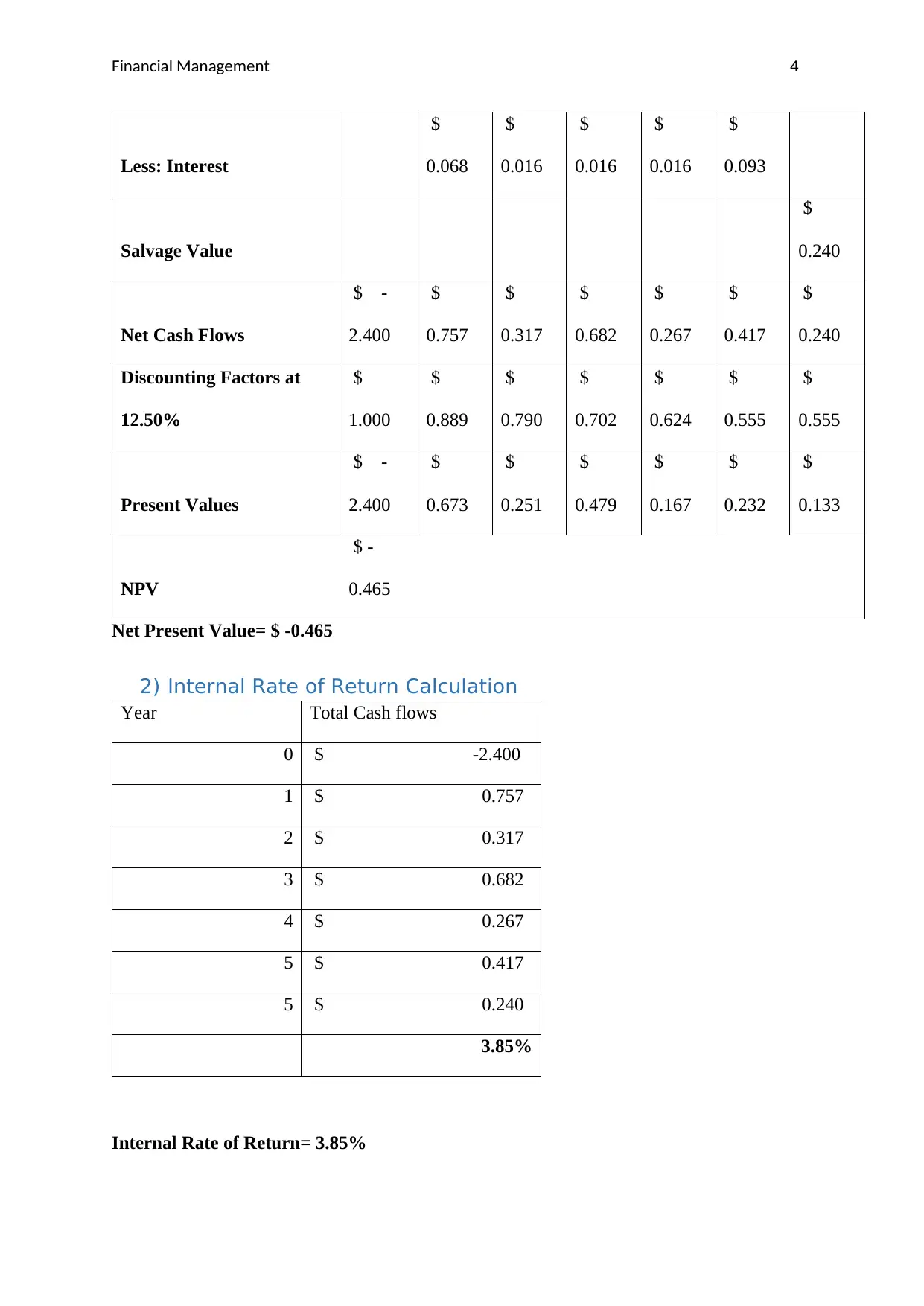
Financial Management 4
Less: Interest
$
0.068
$
0.016
$
0.016
$
0.016
$
0.093
Salvage Value
$
0.240
Net Cash Flows
$ -
2.400
$
0.757
$
0.317
$
0.682
$
0.267
$
0.417
$
0.240
Discounting Factors at
12.50%
$
1.000
$
0.889
$
0.790
$
0.702
$
0.624
$
0.555
$
0.555
Present Values
$ -
2.400
$
0.673
$
0.251
$
0.479
$
0.167
$
0.232
$
0.133
NPV
$ -
0.465
Net Present Value= $ -0.465
2) Internal Rate of Return Calculation
Year Total Cash flows
0 $ -2.400
1 $ 0.757
2 $ 0.317
3 $ 0.682
4 $ 0.267
5 $ 0.417
5 $ 0.240
3.85%
Internal Rate of Return= 3.85%
Less: Interest
$
0.068
$
0.016
$
0.016
$
0.016
$
0.093
Salvage Value
$
0.240
Net Cash Flows
$ -
2.400
$
0.757
$
0.317
$
0.682
$
0.267
$
0.417
$
0.240
Discounting Factors at
12.50%
$
1.000
$
0.889
$
0.790
$
0.702
$
0.624
$
0.555
$
0.555
Present Values
$ -
2.400
$
0.673
$
0.251
$
0.479
$
0.167
$
0.232
$
0.133
NPV
$ -
0.465
Net Present Value= $ -0.465
2) Internal Rate of Return Calculation
Year Total Cash flows
0 $ -2.400
1 $ 0.757
2 $ 0.317
3 $ 0.682
4 $ 0.267
5 $ 0.417
5 $ 0.240
3.85%
Internal Rate of Return= 3.85%
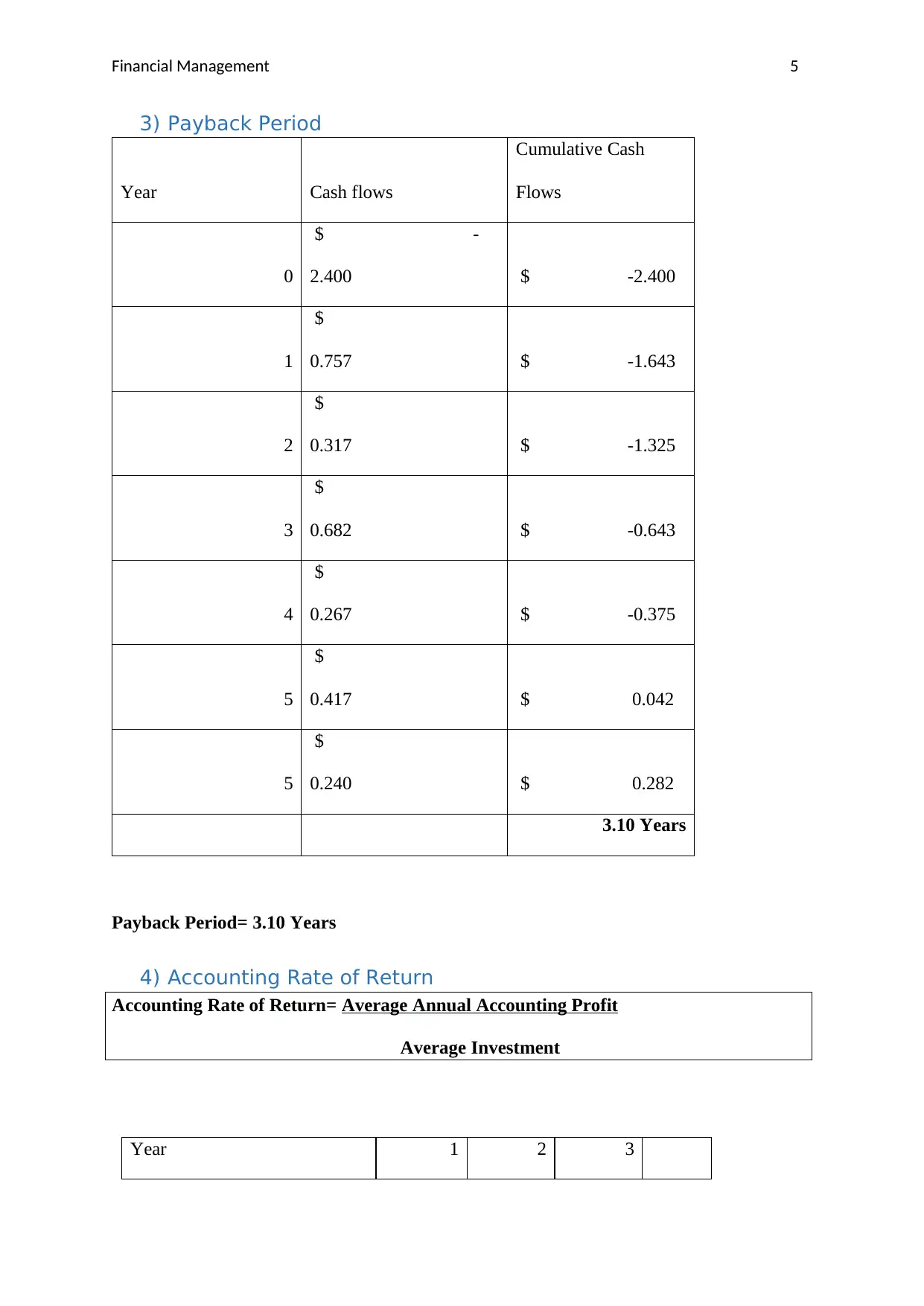
Financial Management 5
3) Payback Period
Year Cash flows
Cumulative Cash
Flows
0
$ -
2.400 $ -2.400
1
$
0.757 $ -1.643
2
$
0.317 $ -1.325
3
$
0.682 $ -0.643
4
$
0.267 $ -0.375
5
$
0.417 $ 0.042
5
$
0.240 $ 0.282
3.10 Years
Payback Period= 3.10 Years
4) Accounting Rate of Return
Accounting Rate of Return= Average Annual Accounting Profit
Average Investment
Year 1 2 3
3) Payback Period
Year Cash flows
Cumulative Cash
Flows
0
$ -
2.400 $ -2.400
1
$
0.757 $ -1.643
2
$
0.317 $ -1.325
3
$
0.682 $ -0.643
4
$
0.267 $ -0.375
5
$
0.417 $ 0.042
5
$
0.240 $ 0.282
3.10 Years
Payback Period= 3.10 Years
4) Accounting Rate of Return
Accounting Rate of Return= Average Annual Accounting Profit
Average Investment
Year 1 2 3
⊘ This is a preview!⊘
Do you want full access?
Subscribe today to unlock all pages.

Trusted by 1+ million students worldwide
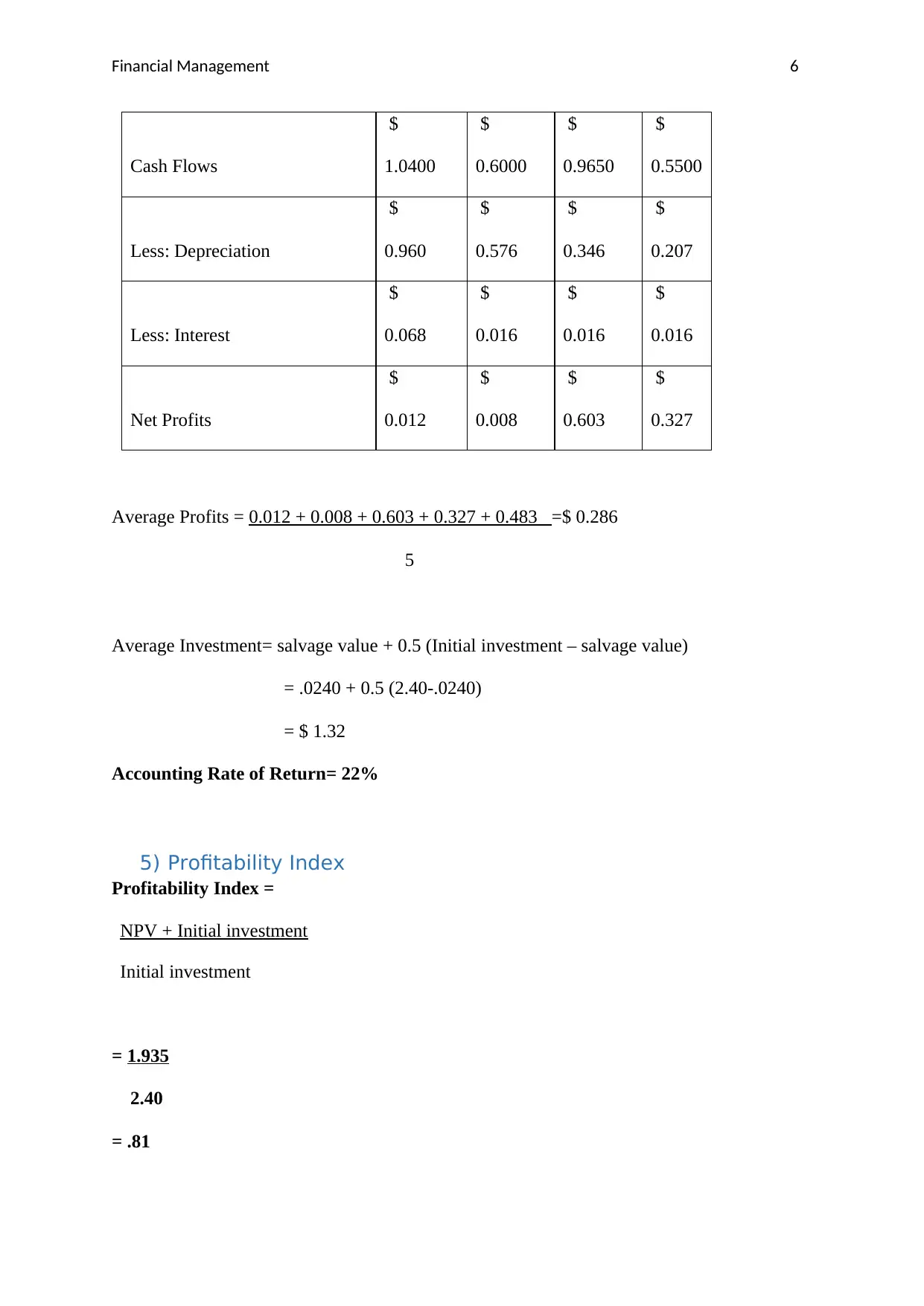
Financial Management 6
Cash Flows
$
1.0400
$
0.6000
$
0.9650
$
0.5500
Less: Depreciation
$
0.960
$
0.576
$
0.346
$
0.207
Less: Interest
$
0.068
$
0.016
$
0.016
$
0.016
Net Profits
$
0.012
$
0.008
$
0.603
$
0.327
Average Profits = 0.012 + 0.008 + 0.603 + 0.327 + 0.483 =$ 0.286
5
Average Investment= salvage value + 0.5 (Initial investment – salvage value)
= .0240 + 0.5 (2.40-.0240)
= $ 1.32
Accounting Rate of Return= 22%
5) Profitability Index
Profitability Index =
NPV + Initial investment
Initial investment
= 1.935
2.40
= .81
Cash Flows
$
1.0400
$
0.6000
$
0.9650
$
0.5500
Less: Depreciation
$
0.960
$
0.576
$
0.346
$
0.207
Less: Interest
$
0.068
$
0.016
$
0.016
$
0.016
Net Profits
$
0.012
$
0.008
$
0.603
$
0.327
Average Profits = 0.012 + 0.008 + 0.603 + 0.327 + 0.483 =$ 0.286
5
Average Investment= salvage value + 0.5 (Initial investment – salvage value)
= .0240 + 0.5 (2.40-.0240)
= $ 1.32
Accounting Rate of Return= 22%
5) Profitability Index
Profitability Index =
NPV + Initial investment
Initial investment
= 1.935
2.40
= .81
Paraphrase This Document
Need a fresh take? Get an instant paraphrase of this document with our AI Paraphraser
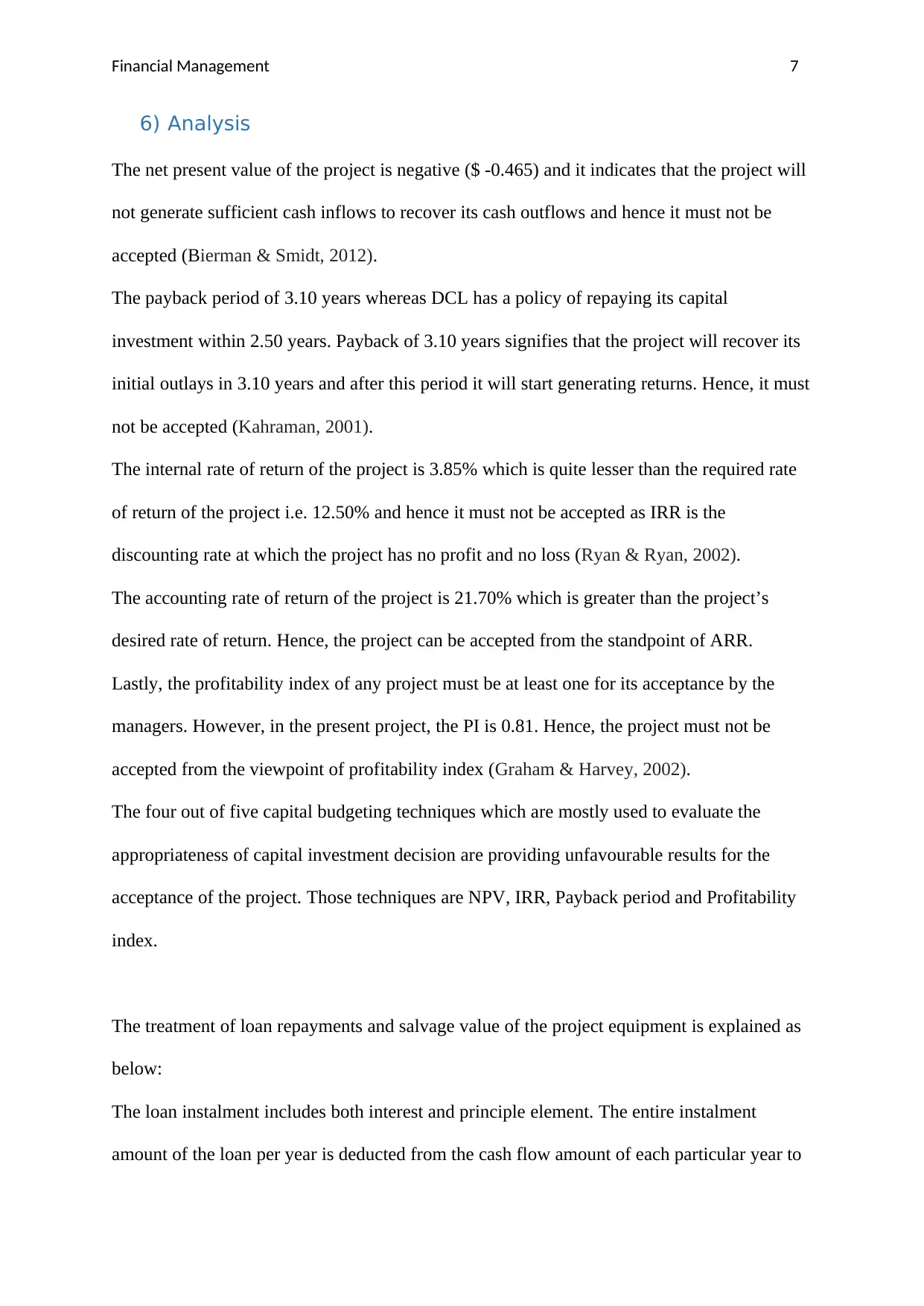
Financial Management 7
6) Analysis
The net present value of the project is negative ($ -0.465) and it indicates that the project will
not generate sufficient cash inflows to recover its cash outflows and hence it must not be
accepted (Bierman & Smidt, 2012).
The payback period of 3.10 years whereas DCL has a policy of repaying its capital
investment within 2.50 years. Payback of 3.10 years signifies that the project will recover its
initial outlays in 3.10 years and after this period it will start generating returns. Hence, it must
not be accepted (Kahraman, 2001).
The internal rate of return of the project is 3.85% which is quite lesser than the required rate
of return of the project i.e. 12.50% and hence it must not be accepted as IRR is the
discounting rate at which the project has no profit and no loss (Ryan & Ryan, 2002).
The accounting rate of return of the project is 21.70% which is greater than the project’s
desired rate of return. Hence, the project can be accepted from the standpoint of ARR.
Lastly, the profitability index of any project must be at least one for its acceptance by the
managers. However, in the present project, the PI is 0.81. Hence, the project must not be
accepted from the viewpoint of profitability index (Graham & Harvey, 2002).
The four out of five capital budgeting techniques which are mostly used to evaluate the
appropriateness of capital investment decision are providing unfavourable results for the
acceptance of the project. Those techniques are NPV, IRR, Payback period and Profitability
index.
The treatment of loan repayments and salvage value of the project equipment is explained as
below:
The loan instalment includes both interest and principle element. The entire instalment
amount of the loan per year is deducted from the cash flow amount of each particular year to
6) Analysis
The net present value of the project is negative ($ -0.465) and it indicates that the project will
not generate sufficient cash inflows to recover its cash outflows and hence it must not be
accepted (Bierman & Smidt, 2012).
The payback period of 3.10 years whereas DCL has a policy of repaying its capital
investment within 2.50 years. Payback of 3.10 years signifies that the project will recover its
initial outlays in 3.10 years and after this period it will start generating returns. Hence, it must
not be accepted (Kahraman, 2001).
The internal rate of return of the project is 3.85% which is quite lesser than the required rate
of return of the project i.e. 12.50% and hence it must not be accepted as IRR is the
discounting rate at which the project has no profit and no loss (Ryan & Ryan, 2002).
The accounting rate of return of the project is 21.70% which is greater than the project’s
desired rate of return. Hence, the project can be accepted from the standpoint of ARR.
Lastly, the profitability index of any project must be at least one for its acceptance by the
managers. However, in the present project, the PI is 0.81. Hence, the project must not be
accepted from the viewpoint of profitability index (Graham & Harvey, 2002).
The four out of five capital budgeting techniques which are mostly used to evaluate the
appropriateness of capital investment decision are providing unfavourable results for the
acceptance of the project. Those techniques are NPV, IRR, Payback period and Profitability
index.
The treatment of loan repayments and salvage value of the project equipment is explained as
below:
The loan instalment includes both interest and principle element. The entire instalment
amount of the loan per year is deducted from the cash flow amount of each particular year to
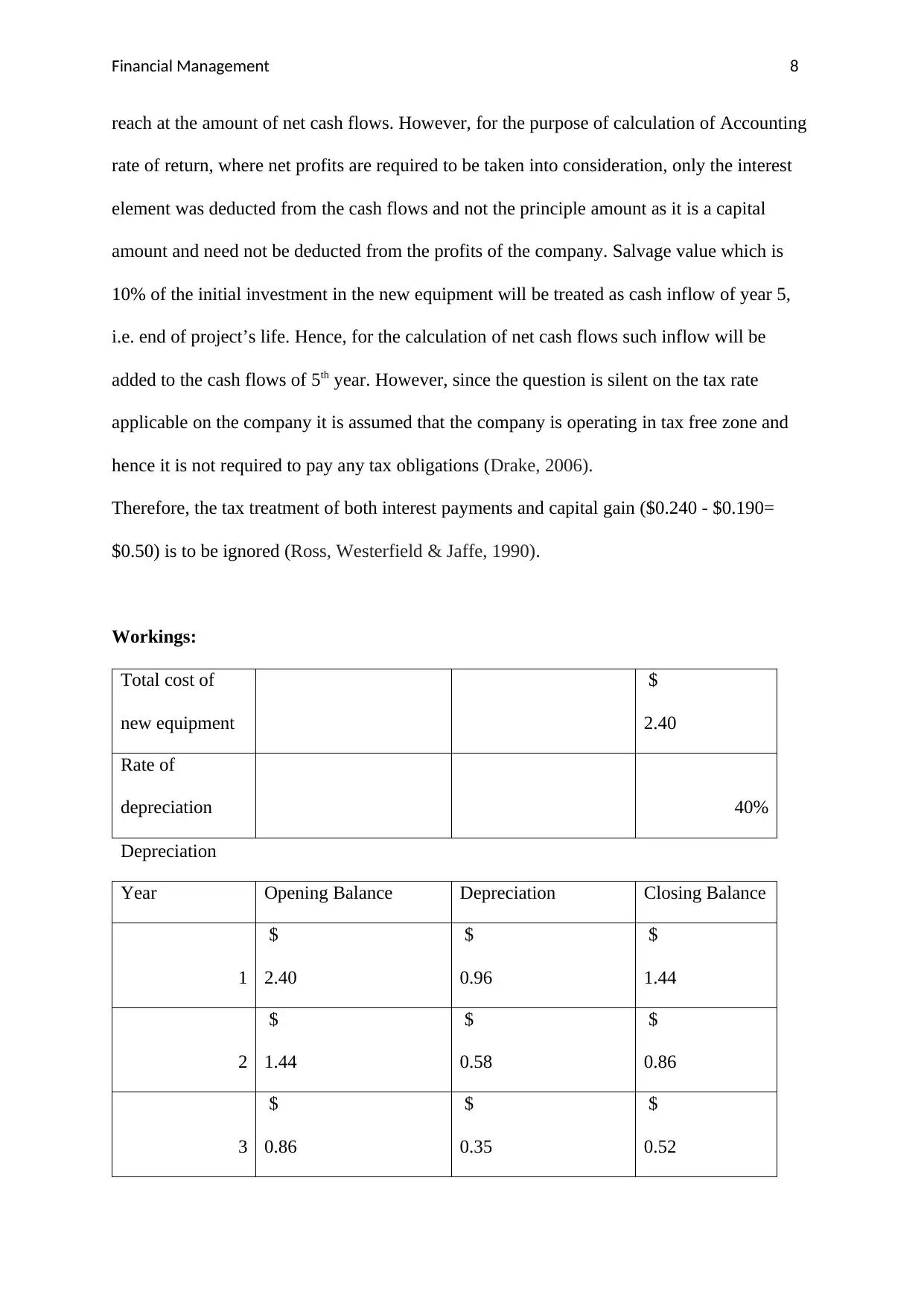
Financial Management 8
reach at the amount of net cash flows. However, for the purpose of calculation of Accounting
rate of return, where net profits are required to be taken into consideration, only the interest
element was deducted from the cash flows and not the principle amount as it is a capital
amount and need not be deducted from the profits of the company. Salvage value which is
10% of the initial investment in the new equipment will be treated as cash inflow of year 5,
i.e. end of project’s life. Hence, for the calculation of net cash flows such inflow will be
added to the cash flows of 5th year. However, since the question is silent on the tax rate
applicable on the company it is assumed that the company is operating in tax free zone and
hence it is not required to pay any tax obligations (Drake, 2006).
Therefore, the tax treatment of both interest payments and capital gain ($0.240 - $0.190=
$0.50) is to be ignored (Ross, Westerfield & Jaffe, 1990).
Workings:
Total cost of
new equipment
$
2.40
Rate of
depreciation 40%
Depreciation
Year Opening Balance Depreciation Closing Balance
1
$
2.40
$
0.96
$
1.44
2
$
1.44
$
0.58
$
0.86
3
$
0.86
$
0.35
$
0.52
reach at the amount of net cash flows. However, for the purpose of calculation of Accounting
rate of return, where net profits are required to be taken into consideration, only the interest
element was deducted from the cash flows and not the principle amount as it is a capital
amount and need not be deducted from the profits of the company. Salvage value which is
10% of the initial investment in the new equipment will be treated as cash inflow of year 5,
i.e. end of project’s life. Hence, for the calculation of net cash flows such inflow will be
added to the cash flows of 5th year. However, since the question is silent on the tax rate
applicable on the company it is assumed that the company is operating in tax free zone and
hence it is not required to pay any tax obligations (Drake, 2006).
Therefore, the tax treatment of both interest payments and capital gain ($0.240 - $0.190=
$0.50) is to be ignored (Ross, Westerfield & Jaffe, 1990).
Workings:
Total cost of
new equipment
$
2.40
Rate of
depreciation 40%
Depreciation
Year Opening Balance Depreciation Closing Balance
1
$
2.40
$
0.96
$
1.44
2
$
1.44
$
0.58
$
0.86
3
$
0.86
$
0.35
$
0.52
⊘ This is a preview!⊘
Do you want full access?
Subscribe today to unlock all pages.

Trusted by 1+ million students worldwide

Financial Management 9
4
$
0.52
$
0.21
$
0.31
5
$
0.31
$
0.12
$
0.19
The tax benefits of depreciation is ignored in the present case as there is no tax rate
given and it is assumed that there is no tax imposed on the company.
4
$
0.52
$
0.21
$
0.31
5
$
0.31
$
0.12
$
0.19
The tax benefits of depreciation is ignored in the present case as there is no tax rate
given and it is assumed that there is no tax imposed on the company.
Paraphrase This Document
Need a fresh take? Get an instant paraphrase of this document with our AI Paraphraser
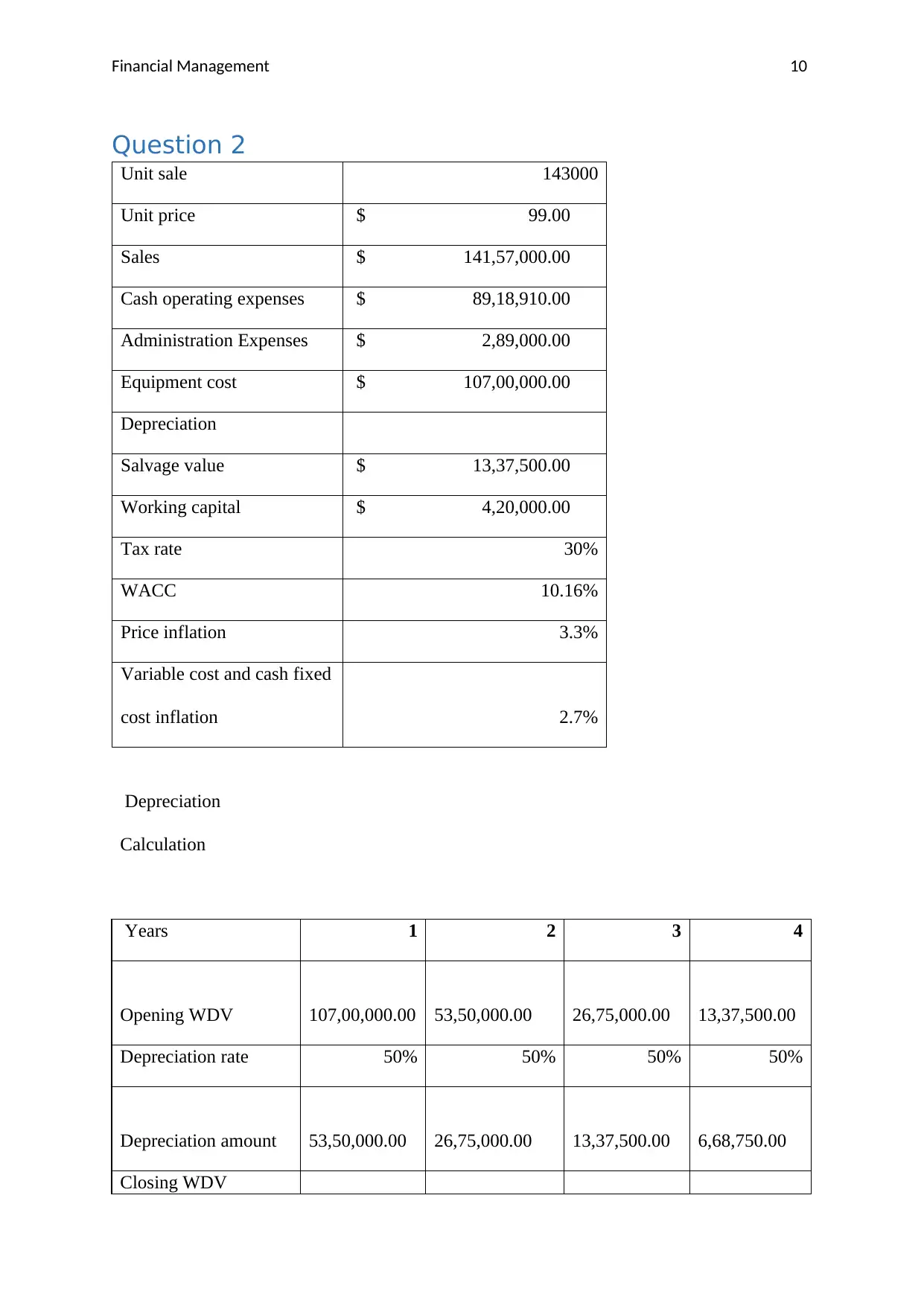
Financial Management 10
Question 2
Unit sale 143000
Unit price $ 99.00
Sales $ 141,57,000.00
Cash operating expenses $ 89,18,910.00
Administration Expenses $ 2,89,000.00
Equipment cost $ 107,00,000.00
Depreciation
Salvage value $ 13,37,500.00
Working capital $ 4,20,000.00
Tax rate 30%
WACC 10.16%
Price inflation 3.3%
Variable cost and cash fixed
cost inflation 2.7%
Depreciation
Calculation
Years 1 2 3 4
Opening WDV 107,00,000.00 53,50,000.00 26,75,000.00 13,37,500.00
Depreciation rate 50% 50% 50% 50%
Depreciation amount 53,50,000.00 26,75,000.00 13,37,500.00 6,68,750.00
Closing WDV
Question 2
Unit sale 143000
Unit price $ 99.00
Sales $ 141,57,000.00
Cash operating expenses $ 89,18,910.00
Administration Expenses $ 2,89,000.00
Equipment cost $ 107,00,000.00
Depreciation
Salvage value $ 13,37,500.00
Working capital $ 4,20,000.00
Tax rate 30%
WACC 10.16%
Price inflation 3.3%
Variable cost and cash fixed
cost inflation 2.7%
Depreciation
Calculation
Years 1 2 3 4
Opening WDV 107,00,000.00 53,50,000.00 26,75,000.00 13,37,500.00
Depreciation rate 50% 50% 50% 50%
Depreciation amount 53,50,000.00 26,75,000.00 13,37,500.00 6,68,750.00
Closing WDV
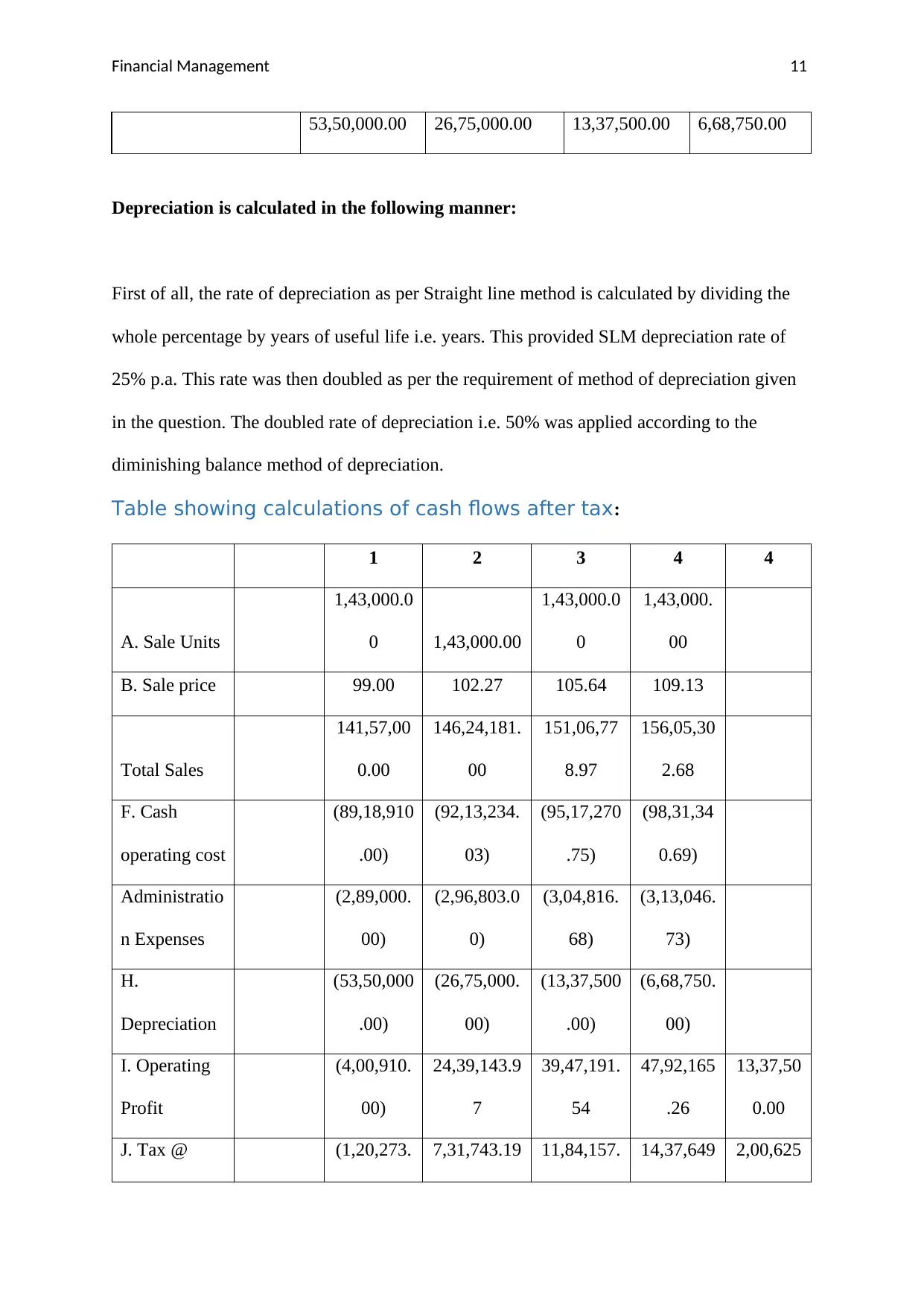
Financial Management 11
53,50,000.00 26,75,000.00 13,37,500.00 6,68,750.00
Depreciation is calculated in the following manner:
First of all, the rate of depreciation as per Straight line method is calculated by dividing the
whole percentage by years of useful life i.e. years. This provided SLM depreciation rate of
25% p.a. This rate was then doubled as per the requirement of method of depreciation given
in the question. The doubled rate of depreciation i.e. 50% was applied according to the
diminishing balance method of depreciation.
Table showing calculations of cash flows after tax:
1 2 3 4 4
A. Sale Units
1,43,000.0
0 1,43,000.00
1,43,000.0
0
1,43,000.
00
B. Sale price 99.00 102.27 105.64 109.13
Total Sales
141,57,00
0.00
146,24,181.
00
151,06,77
8.97
156,05,30
2.68
F. Cash
operating cost
(89,18,910
.00)
(92,13,234.
03)
(95,17,270
.75)
(98,31,34
0.69)
Administratio
n Expenses
(2,89,000.
00)
(2,96,803.0
0)
(3,04,816.
68)
(3,13,046.
73)
H.
Depreciation
(53,50,000
.00)
(26,75,000.
00)
(13,37,500
.00)
(6,68,750.
00)
I. Operating
Profit
(4,00,910.
00)
24,39,143.9
7
39,47,191.
54
47,92,165
.26
13,37,50
0.00
J. Tax @ (1,20,273. 7,31,743.19 11,84,157. 14,37,649 2,00,625
53,50,000.00 26,75,000.00 13,37,500.00 6,68,750.00
Depreciation is calculated in the following manner:
First of all, the rate of depreciation as per Straight line method is calculated by dividing the
whole percentage by years of useful life i.e. years. This provided SLM depreciation rate of
25% p.a. This rate was then doubled as per the requirement of method of depreciation given
in the question. The doubled rate of depreciation i.e. 50% was applied according to the
diminishing balance method of depreciation.
Table showing calculations of cash flows after tax:
1 2 3 4 4
A. Sale Units
1,43,000.0
0 1,43,000.00
1,43,000.0
0
1,43,000.
00
B. Sale price 99.00 102.27 105.64 109.13
Total Sales
141,57,00
0.00
146,24,181.
00
151,06,77
8.97
156,05,30
2.68
F. Cash
operating cost
(89,18,910
.00)
(92,13,234.
03)
(95,17,270
.75)
(98,31,34
0.69)
Administratio
n Expenses
(2,89,000.
00)
(2,96,803.0
0)
(3,04,816.
68)
(3,13,046.
73)
H.
Depreciation
(53,50,000
.00)
(26,75,000.
00)
(13,37,500
.00)
(6,68,750.
00)
I. Operating
Profit
(4,00,910.
00)
24,39,143.9
7
39,47,191.
54
47,92,165
.26
13,37,50
0.00
J. Tax @ (1,20,273. 7,31,743.19 11,84,157. 14,37,649 2,00,625
⊘ This is a preview!⊘
Do you want full access?
Subscribe today to unlock all pages.

Trusted by 1+ million students worldwide
1 out of 20
Your All-in-One AI-Powered Toolkit for Academic Success.
+13062052269
info@desklib.com
Available 24*7 on WhatsApp / Email
![[object Object]](/_next/static/media/star-bottom.7253800d.svg)
Unlock your academic potential
Copyright © 2020–2025 A2Z Services. All Rights Reserved. Developed and managed by ZUCOL.

